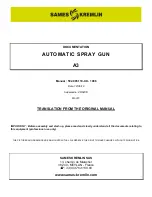
EN
PL
14
RU
DE
FR
OPERATING INSTRUCTIONS
Unscrew the pump from the head – to do so, lock the piston rod (Fig. 4b/pos. 1) in the cylinder holders
(Fig. 4b/pos. 2). When unscrewing the pump, hold the piston rod in hand (Fig. 4b/pos. 1), and turn it
anticlockwise.
Piston rod unlocked
Fig.4a
Piston rod locked
Fig.4b
2
1
1
Insert the strainer (Fig. 5/pos. 1) into the head socket (Fig. 5/pos. 2) and pour water.
Remove the sieve (Fig. 5/pos. 1) from the head socket (Fig. 5/pos. 2).
It is forbidden to block or alter the safety valve in any way.
WORKING WITH THE DEVICE
Unscrew the pump from the head – to do so, lock the piston rod (Fig. 4b/pos. 1) in the cylinder holders (Fig.
4b/pos. 2). When unscrewing the pump, hold the piston rod in hand (Fig. 4b/pos. 1), and turn it anticlockwise.
Insert the strainer (Fig. 5/pos. 1) into the head socket (Fig. 5/pos. 2) and pour in the working liquid.
Remove the sieve (Fig. 5/pos. 1) from the head socket (Fig. 5/pos. 2). Screw the pump (Fig. 1/pos. 3) into
the head (Fig. 1/pos. 2). To this end, lock the pump’s piston rod (Fig. 4b/pos. 1) in the cylinder holders (Fig.
4b/pos. 2). Remember to keep the connection tight. When locked this way, the piston rod can be used as a
handle for transporting.
Clean the sieve from any potential impurities.
Screw in the pump and perform several piston rod
movements (Fig. 3c) to make the safety valve (Fig. 3a)
open automatically. Remember to keep the connection
tight. If the valve is working properly, the valve stem
(Fig. 3a/pos. 1) will go up (the valve will open) accom-
panied by the sound of escaping air.
Fig.5
2
1
2















































